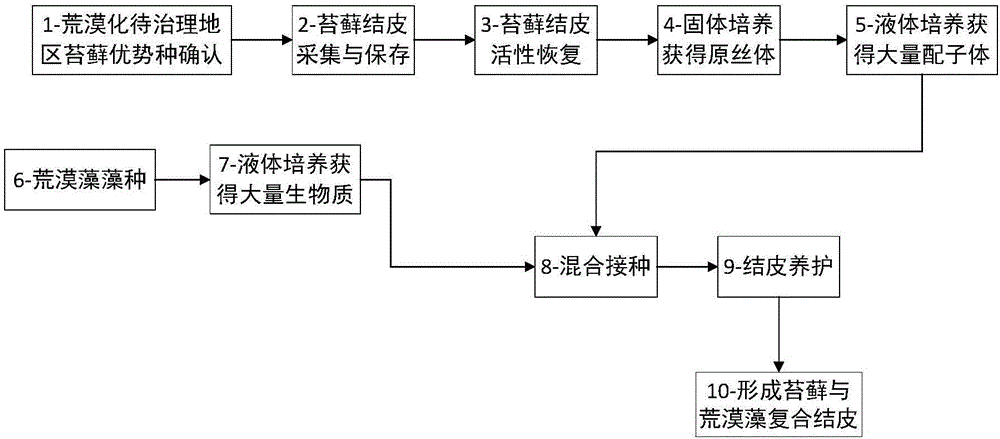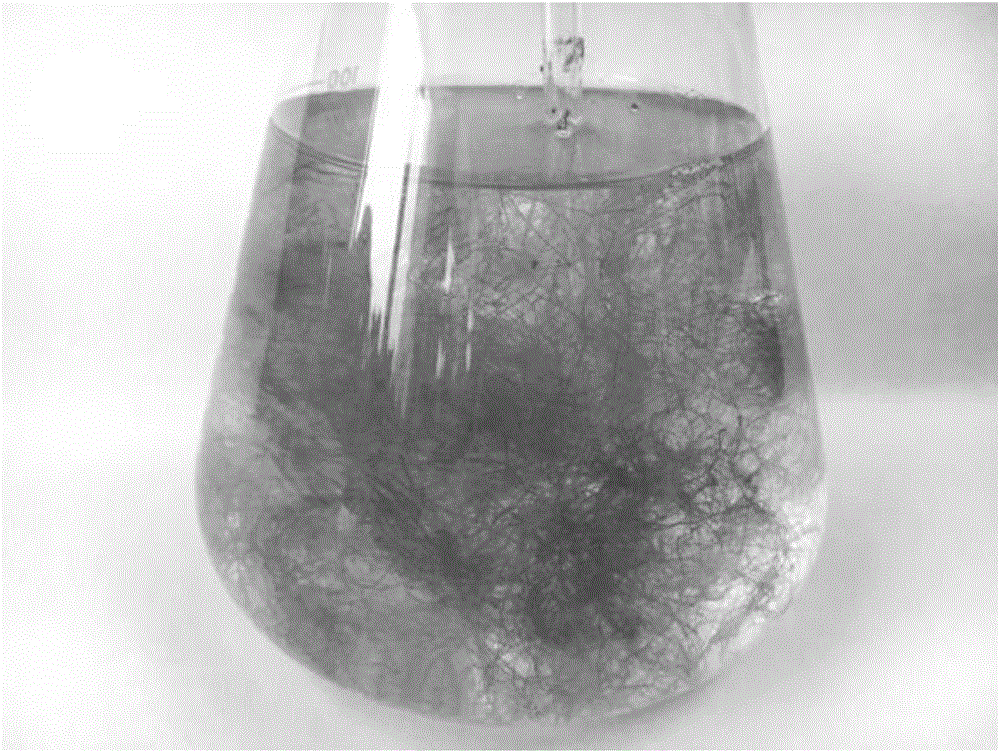Cultivation method of moss and desert algae composite crust
A cultivation method and technology of moss crust, applied in the field of cultivation of moss and desert algae composite crust, can solve the problems such as difficulty in large-scale production, improve species diversity and viability, accelerate succession process, and improve substrate The effect of conditions and circumstances
- Summary
- Abstract
- Description
- Claims
- Application Information
AI Technical Summary
Problems solved by technology
Method used
Image
Examples
Embodiment 1
[0033] according to figure 1 As can be seen, a method for cultivating moss and desert algae composite crust, the steps are:
[0034] 1. Confirmation of moss dominant species in the desertification area to be rehabilitated 1 and collection and preservation of moss crusts 2: According to extensive investigations, identify the dominant moss species of biological soil crusts in the natural habitat of the area to be rehabilitated in summer, and select the well-developed moss species. For moss crusts, the superficial crusts were collected with a ring knife, and air-dried at room temperature for 10, 13, or 15 days for later use.
[0035] 2. Moss crust activity recovery 3: The activity of the moss crust is recovered. The air-dried moss samples are sprayed with water to be completely moistened and then cultured for at least 48 hours to recover their activity; 15 °C with light intensity of 5 or 10 or 15 or 20 μmol m -2 s -1 , the light-dark cycle is 12 / 12, and the humidity is 60 or ...
Embodiment 2
[0049] according to figure 1 As can be seen, a method for cultivating moss and desert algae composite crust, the steps are:
[0050] The investigation found that moss ( Bryum argenteum ) and P. terrestris ( Didymodon vinealis ) are widely distributed in Dalat Banner, Inner Mongolia Autonomous Region. Two well-developed moss crusts were selected and stored separately after air-drying. The air-dried moss samples were sprayed with water until completely wet, and the temperature was 15 °C and the light intensity was 20 μmol m -2 s -1 , with a light-dark cycle of 12 / 12 and a humidity of 80% for at least 48 hours to recover its activity. After recovery, the moss crusts were washed with distilled water to remove the sandy soil to obtain moss gametophytes. Gametocytes were washed three times in sterile distilled water. It was then disinfected with 5% sodium hypochlorite by mass for 10 seconds, and then washed three times with distilled water. The sterilized moss gametophyte...
Embodiment 3
[0057] The culture method of P. terrestris gametophyte is the same as that in Example 1.
[0058] Microsphingomyelinae and Pseudomonas javanica were cultured separately ( Scytonema javanicum ) to the logarithmic phase, and the culture method was the same as that in Example 1 or Example 2.
[0059] Mix the gametophyte of P. sylvatica with Microsphingoencephala and Pseudomonas javanica according to the dry weight ratio of 1:5:3, and then spray and inoculate on the surface of the sand after mixing evenly. and Pseudomonas javanica total dry weight of 0.9 g m -2 .
[0060] Maintenance after skin inoculation was the same as in Example 1 or Example 2.
[0061] After one month, the initial composite crust of Paradontia terrestris, Microsphingoencephala and Pseudomonas javanica can be formed, and the crust coverage can reach about 94%, of which the coverage of moss can reach 50%-92%.
PUM
 Login to View More
Login to View More Abstract
Description
Claims
Application Information
 Login to View More
Login to View More - R&D
- Intellectual Property
- Life Sciences
- Materials
- Tech Scout
- Unparalleled Data Quality
- Higher Quality Content
- 60% Fewer Hallucinations
Browse by: Latest US Patents, China's latest patents, Technical Efficacy Thesaurus, Application Domain, Technology Topic, Popular Technical Reports.
© 2025 PatSnap. All rights reserved.Legal|Privacy policy|Modern Slavery Act Transparency Statement|Sitemap|About US| Contact US: help@patsnap.com



